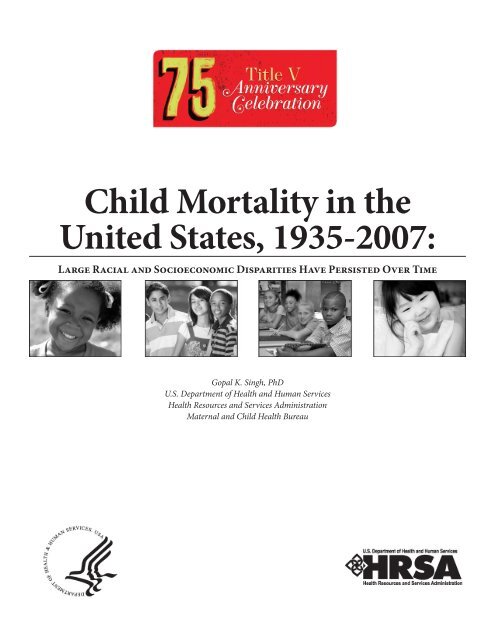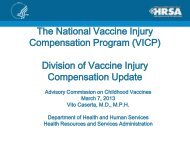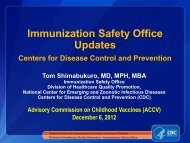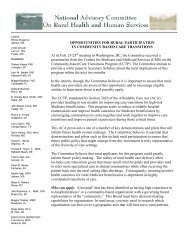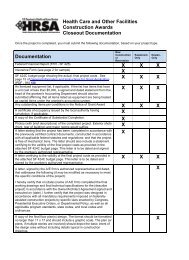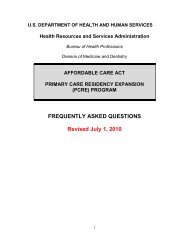Child Mortality in the United States, 1935-2007: - HRSA
Child Mortality in the United States, 1935-2007: - HRSA
Child Mortality in the United States, 1935-2007: - HRSA
You also want an ePaper? Increase the reach of your titles
YUMPU automatically turns print PDFs into web optimized ePapers that Google loves.
<strong>Child</strong> <strong>Mortality</strong> <strong>in</strong> <strong>the</strong><br />
<strong>United</strong> <strong>States</strong>, <strong>1935</strong>-<strong>2007</strong>:<br />
Large Racial and Socioeconomic Disparities Have Persisted Over Time<br />
Gopal K. S<strong>in</strong>gh, PhD<br />
U.S. Department of Health and Human Services<br />
Health Resources and Services Adm<strong>in</strong>istration<br />
Maternal and <strong>Child</strong> Health Bureau
Figure 1: Death Rates for <strong>Child</strong>ren Aged 1-4 Years<br />
by Race, <strong>United</strong> <strong>States</strong>, <strong>1935</strong>-<strong>2007</strong><br />
Figure 2: Death Rates for <strong>Child</strong>ren Aged 5-14 Years<br />
by Race, <strong>United</strong> <strong>States</strong>, <strong>1935</strong>-<strong>2007</strong><br />
<strong>Child</strong> mortality <strong>in</strong> <strong>the</strong> <strong>United</strong> <strong>States</strong> has decl<strong>in</strong>ed<br />
dramatically over <strong>the</strong> past century (1-5). The mortality rate<br />
for children aged 1-4 years decl<strong>in</strong>ed from 1,418.8 deaths<br />
per 100,000 population <strong>in</strong> 1907 to 28.6 <strong>in</strong> <strong>2007</strong> (3, 4). The<br />
mortality rate for children aged 5-14 years decl<strong>in</strong>ed from<br />
307.5 <strong>in</strong> 1907 to 15.3 <strong>in</strong> <strong>2007</strong> (3, 4). In 1900-1902, 90.2%<br />
of U.S. children aged 1 year survived to age 15, compared<br />
to 99.7% of children <strong>in</strong> <strong>2007</strong> (2, 4). Despite such impressive<br />
reductions <strong>in</strong> overall child mortality, large racial and ethnic<br />
disparities have cont<strong>in</strong>ued to exist <strong>in</strong> <strong>the</strong> <strong>United</strong> <strong>States</strong>, and<br />
<strong>the</strong> recent evidence po<strong>in</strong>ts to a widen<strong>in</strong>g of socioeconomic<br />
<strong>in</strong>equalities <strong>in</strong> child mortality (2, 3).<br />
In this brief report, we analyze long-term trends <strong>in</strong><br />
mortality among children aged 1-4 and 5-14 years accord<strong>in</strong>g<br />
to race/ethnicity, sex, cause of death, family poverty<br />
level, and state of residence by us<strong>in</strong>g both historical and <strong>the</strong><br />
latest national vital statistics data (3-5). As shown below, <strong>the</strong><br />
impressive decl<strong>in</strong>e <strong>in</strong> <strong>the</strong> overall child mortality rates over<br />
<strong>the</strong> long term has been due to large reductions <strong>in</strong> mortality<br />
from un<strong>in</strong>tentional <strong>in</strong>juries, pneumonia and <strong>in</strong>fluenza,<br />
cancer, and birth defects.<br />
Trends <strong>in</strong> <strong>Mortality</strong> among <strong>Child</strong>ren Aged 1-4 and 5-14<br />
Years by Race and Sex<br />
Although mortality trend data extend far<strong>the</strong>r back <strong>in</strong><br />
time for <strong>the</strong> entire <strong>United</strong> <strong>States</strong> and <strong>the</strong> birth and death<br />
registration areas, we chose <strong>1935</strong> as <strong>the</strong> start of <strong>the</strong> time<br />
trend analysis s<strong>in</strong>ce it co<strong>in</strong>cided with <strong>the</strong> <strong>in</strong>ception of Title V<br />
of <strong>the</strong> Social Security Act, a national public health legislation<br />
aimed at promot<strong>in</strong>g and improv<strong>in</strong>g <strong>the</strong> health and welfare<br />
services for all mo<strong>the</strong>rs and children. The death rate for children<br />
aged 1-4 years showed a consistently downward trend<br />
between <strong>1935</strong> and <strong>2007</strong>, decreas<strong>in</strong>g at a rapid rate of 3.3%<br />
per year (Figure 1). Although <strong>the</strong> rate of decl<strong>in</strong>e <strong>in</strong> mortality<br />
among both white and black children aged 1-4 was similar<br />
dur<strong>in</strong>g <strong>1935</strong>-<strong>2007</strong>, black children had 1.6 to 2.0 times higher<br />
mortality than white children throughout this period (Figure<br />
1). In <strong>2007</strong>, <strong>the</strong> death rate for black children aged 1-4 was<br />
43.7 deaths per 100,000 population, 69% higher than <strong>the</strong><br />
rate for white children (25.8). The detailed racial/ethnic data<br />
<strong>in</strong> <strong>2007</strong> <strong>in</strong>dicate <strong>the</strong> lowest death rate among Asian/Pacific<br />
Islander children aged 1-4 years (20.9), followed by Hispanics<br />
(25.2), non-Hispanic whites (25.5), American Indians/<br />
Alaska Natives (39.2), and blacks (43.7). As for <strong>the</strong> trend <strong>in</strong><br />
sex differentials dur<strong>in</strong>g <strong>the</strong> past 6 decades, <strong>the</strong> death rate<br />
for male children aged 1-4 has been approximately 15-30%<br />
higher than <strong>the</strong> rate for female children.
Figure 3: Lead<strong>in</strong>g Causes of Death among <strong>Child</strong>ren Aged<br />
1-4, <strong>United</strong> <strong>States</strong>, <strong>2007</strong><br />
Figure 4: Lead<strong>in</strong>g Causes of Death among <strong>Child</strong>ren Aged<br />
1-4, <strong>United</strong> <strong>States</strong>, 1970<br />
Figure 5: Lead<strong>in</strong>g Causes of Death among <strong>Child</strong>ren Aged<br />
5-14, <strong>United</strong> <strong>States</strong>, <strong>2007</strong><br />
Figure 6: Lead<strong>in</strong>g Causes of Death among <strong>Child</strong>ren Aged<br />
5-14, <strong>United</strong> <strong>States</strong>, 1970
Figure 7: All-Cause <strong>Mortality</strong> Among <strong>Child</strong>ren Aged 1-14<br />
Years by County-Level Family Poverty Rate, <strong>United</strong> <strong>States</strong>,<br />
1969-<strong>2007</strong><br />
Figure 8: Relative Risk of All-Cause <strong>Child</strong> <strong>Mortality</strong> by<br />
County-Level Family Poverty Rate, 1969-<strong>2007</strong><br />
<strong>Mortality</strong> among children aged 5-14 years also showed<br />
a consistently downward trend dur<strong>in</strong>g <strong>1935</strong>-<strong>2007</strong>, with <strong>the</strong><br />
rate decreas<strong>in</strong>g from 150.0 deaths per 100,000 population<br />
<strong>in</strong> <strong>1935</strong> to 15.3 <strong>in</strong> <strong>2007</strong> (Figure 2). The average rate of<br />
decl<strong>in</strong>e <strong>in</strong> mortality among children aged 5-14 was 2.7% per<br />
year dur<strong>in</strong>g this period, significantly lower than <strong>the</strong> pace of<br />
mortality decl<strong>in</strong>e for younger children aged 1-4. Although<br />
death rates for both white and black children aged 5-14<br />
years decl<strong>in</strong>ed at a similar pace dur<strong>in</strong>g <strong>1935</strong>-<strong>2007</strong>, <strong>the</strong><br />
relative risk of mortality was 33-75% higher among black<br />
children than white children dur<strong>in</strong>g this period. Accord<strong>in</strong>g to<br />
<strong>the</strong> detailed racial/ethnic data <strong>in</strong> <strong>2007</strong>, Asian/Pacific Islander<br />
children aged 5-14 years had <strong>the</strong> lowest death rate (10.9),<br />
followed by Hispanics (14.1), non-Hispanic whites (14.2),<br />
American Indians/Alaska Natives (17.0), and blacks (21.0).<br />
Regard<strong>in</strong>g <strong>the</strong> trend <strong>in</strong> sex differentials dur<strong>in</strong>g <strong>the</strong> past 6<br />
decades, <strong>the</strong> relative risk of mortality for male children aged<br />
5-14 years has been approximately 30-70% higher than that<br />
for female children.<br />
Lead<strong>in</strong>g Causes of <strong>Child</strong> <strong>Mortality</strong><br />
In <strong>2007</strong>, un<strong>in</strong>tentional <strong>in</strong>juries, birth defects, homicide,<br />
cancer, and heart disease were <strong>the</strong> top five lead<strong>in</strong>g causes<br />
of death of children aged 1-4, account<strong>in</strong>g for two-thirds of<br />
all deaths <strong>in</strong> <strong>2007</strong> (Figure 3). Deaths from motor vehicle<br />
accidents accounted for approximately 37% of all un<strong>in</strong>tentional<br />
<strong>in</strong>jury deaths among younger children <strong>in</strong> <strong>2007</strong> (3).<br />
Pneumonia and <strong>in</strong>fluenza were <strong>the</strong> fourth lead<strong>in</strong>g cause<br />
of death <strong>in</strong> 1970 (Figure 4). HIV/AIDS, which was not a<br />
prom<strong>in</strong>ent cause of death <strong>in</strong> <strong>2007</strong>, contributed substantially<br />
to young children’s mortality from 1987 through 1996 dur<strong>in</strong>g<br />
which <strong>the</strong> mortality rate from it doubled. While mortality<br />
rates from such lead<strong>in</strong>g causes of death as un<strong>in</strong>tentional<br />
<strong>in</strong>juries, birth defects, pneumonia and <strong>in</strong>fluenza, cancer, and<br />
COPD decl<strong>in</strong>ed by 66-71% between 1970 and <strong>2007</strong>, <strong>the</strong><br />
homicide rate for children aged 1-4 <strong>in</strong>creased by 26%.<br />
Un<strong>in</strong>tentional <strong>in</strong>juries, cancer, birth defects, homicide,<br />
heart disease, and suicide were <strong>the</strong> lead<strong>in</strong>g causes of<br />
death of older children aged 5-14, account<strong>in</strong>g for 70% of all<br />
deaths <strong>in</strong> <strong>2007</strong> (Figure 5). Although HIV/AIDS accounted<br />
for only 10 deaths among children aged 5-14 <strong>in</strong> <strong>2007</strong>, it<br />
was a lead<strong>in</strong>g cause of death for older children <strong>in</strong> <strong>the</strong> late<br />
1980s through <strong>the</strong> mid-1990s. Although mortality from such<br />
lead<strong>in</strong>g causes of death as un<strong>in</strong>tentional <strong>in</strong>juries, cancer,<br />
birth defects, pneumonia and <strong>in</strong>fluenza, and stroke fell<br />
by 59-73% between 1970 and <strong>2007</strong>, <strong>the</strong> suicide rate for<br />
children aged 10-14 years <strong>in</strong>creased by 44% (Figures 5<br />
and 6). No change <strong>in</strong> homicide and COPD mortality rates<br />
occurred between 1970 and <strong>2007</strong> for older children.
Figure 9: Un<strong>in</strong>tentional Injury <strong>Mortality</strong> Among <strong>Child</strong>ren<br />
Aged 1-14 Years by County-Level Family Poverty Rate,<br />
<strong>United</strong> <strong>States</strong>, 1969-<strong>2007</strong><br />
Figure 10: Relative Risk of Un<strong>in</strong>tentional Injury <strong>Mortality</strong><br />
among <strong>Child</strong>ren Aged 1-14 Years by County-Level Family<br />
Poverty Rate, <strong>United</strong> <strong>States</strong>, 1969-<strong>2007</strong><br />
below <strong>the</strong> poverty level <strong>in</strong> a county, referred to as <strong>the</strong> low<br />
poverty group), 5-14.99% (middle poverty group), and<br />
15% or higher (high poverty group) [2, 6, 7]. Details of <strong>the</strong><br />
l<strong>in</strong>kage methodology are provided elsewhere (2). Dur<strong>in</strong>g<br />
1969-<strong>2007</strong>, <strong>the</strong> all-cause mortality rate for children <strong>in</strong> <strong>the</strong><br />
low poverty group decl<strong>in</strong>ed by 65.8%, whereas <strong>the</strong> rate for<br />
children <strong>in</strong> <strong>the</strong> high poverty group decreased by 57.5% (Figure<br />
7). The slower decl<strong>in</strong>e <strong>in</strong> mortality among higher poverty<br />
groups contributed to <strong>the</strong> widen<strong>in</strong>g socioeconomic gap <strong>in</strong><br />
all-cause child mortality. All relative risks of mortality for<br />
<strong>the</strong> poverty groups were statistically significant. Compared<br />
to children <strong>in</strong> <strong>the</strong> low poverty group, children <strong>in</strong> <strong>the</strong> middle<br />
poverty and high poverty groups had 21% and 52% higher<br />
all-cause mortality risks <strong>in</strong> 1969-1971 and 31% and 88%<br />
higher all-cause mortality risks <strong>in</strong> 2003-<strong>2007</strong>, respectively<br />
(Figure 8).<br />
S<strong>in</strong>ce un<strong>in</strong>tentional <strong>in</strong>juries and violence account for<br />
nearly 50% of all child deaths, socioeconomic trends <strong>in</strong> child<br />
mortality from un<strong>in</strong>tentional <strong>in</strong>juries and homicide were also<br />
analyzed. Socioeconomic disparities <strong>in</strong> child mortality from<br />
un<strong>in</strong>tentional <strong>in</strong>juries were greater than those <strong>in</strong> all-cause<br />
mortality. Dur<strong>in</strong>g 1969-<strong>2007</strong>, un<strong>in</strong>tentional <strong>in</strong>jury mortality<br />
rates decl<strong>in</strong>ed faster for children <strong>in</strong> <strong>the</strong> low poverty group<br />
compared to children <strong>in</strong> <strong>the</strong> higher poverty groups, lead<strong>in</strong>g<br />
to <strong>in</strong>creased socioeconomic disparities <strong>in</strong> un<strong>in</strong>tentional<br />
<strong>in</strong>jury mortality over time (Figures 9 and 10). Compared<br />
to children <strong>in</strong> <strong>the</strong> low poverty group, children <strong>in</strong> <strong>the</strong> high<br />
poverty group had a 61% higher risk of un<strong>in</strong>tentional <strong>in</strong>jury<br />
mortality <strong>in</strong> 1969-1971 but a 154% higher mortality risk <strong>in</strong><br />
2003-<strong>2007</strong> (Figure 10).<br />
Homicide rates <strong>in</strong>creased from 1969 to 1995 and <strong>the</strong>n<br />
decreased through <strong>2007</strong> for children <strong>in</strong> each socioeconomic<br />
group (data not shown). However, <strong>the</strong> socioeconomic<br />
disparities rema<strong>in</strong>ed large dur<strong>in</strong>g <strong>the</strong> entire 1969-<strong>2007</strong> time<br />
period. Compared to children <strong>in</strong> <strong>the</strong> low poverty group,<br />
children <strong>in</strong> <strong>the</strong> high poverty group had 144%, 195%, and<br />
165% higher homicide rates <strong>in</strong> 1969-1971, 1990-1992, and<br />
2003-<strong>2007</strong>, respectively.<br />
Trends <strong>in</strong> Socioeconomic Disparities <strong>in</strong> <strong>Child</strong> <strong>Mortality</strong><br />
S<strong>in</strong>ce household socioeconomic data are not available<br />
<strong>in</strong> national mortality statistics, county-level family poverty<br />
data from <strong>the</strong> 1990 and 2000 censuses were l<strong>in</strong>ked with<br />
county-level mortality data to compute mortality rates<br />
from 1969 to <strong>2007</strong> for children aged 1-14 years <strong>in</strong> three<br />
poverty rate categories:
Figure 11: Death Rates per 100,000 Population for <strong>Child</strong>ren Aged 1-4 Years, 2003-<strong>2007</strong><br />
Figure 12: Death Rates per 100,000 Population for <strong>Child</strong>ren Aged 5-14 years, 2003-<strong>2007</strong>
Dur<strong>in</strong>g 2005-<strong>2007</strong>, mortality among children aged 5-14<br />
was substantially higher <strong>in</strong> <strong>the</strong> Sou<strong>the</strong>astern and Southwestern<br />
regions and lower <strong>in</strong> New England, with <strong>the</strong> rate<br />
rang<strong>in</strong>g from a low of 10.3 <strong>in</strong> Massachusetts to a high of<br />
31.1 <strong>in</strong> Alaska and 27.0 for <strong>the</strong> District of Columbia (Figure<br />
12). The geographic pattern <strong>in</strong> mortality for children aged<br />
5-14 was similar to that for children aged 1-4.<br />
Discussion<br />
Monitor<strong>in</strong>g changes <strong>in</strong> <strong>the</strong> health and well-be<strong>in</strong>g of<br />
children is one of <strong>the</strong> most important goals of <strong>the</strong> U.S.<br />
Department of Health and Human Services (8). Dramatic<br />
reductions <strong>in</strong> mortality rates over <strong>the</strong> long term for children<br />
<strong>in</strong> all racial and socioeconomic groups should, undoubtedly,<br />
be seen as a major public health success (2). These reductions<br />
<strong>in</strong> <strong>the</strong> overall child mortality rate were due to large<br />
decl<strong>in</strong>es <strong>in</strong> mortality from un<strong>in</strong>tentional <strong>in</strong>juries, pneumonia<br />
and <strong>in</strong>fluenza, cancer, and birth defects (1, 2). However,<br />
trends <strong>in</strong> child mortality from violent deaths have been less<br />
encourag<strong>in</strong>g as homicide rates for children aged 1-14 and<br />
suicide rates for children aged 10-14, even though <strong>the</strong>y<br />
are currently lower than <strong>the</strong> peak rates of <strong>the</strong> mid-1990s,<br />
<strong>in</strong>creased significantly between 1969 and <strong>2007</strong>.<br />
Improvements <strong>in</strong> liv<strong>in</strong>g conditions, better nutrition,<br />
advances <strong>in</strong> medical care, and <strong>the</strong> <strong>in</strong>troduction of Medicaid<br />
<strong>in</strong> 1965 have been cited as factors responsible for <strong>the</strong><br />
long-term decl<strong>in</strong>e <strong>in</strong> child mortality, particularly from such<br />
medical or “biologic” causes as pneumonia and <strong>in</strong>fluenza,<br />
cancer, and birth defects (1, 2). Un<strong>in</strong>tentional <strong>in</strong>jury mortality<br />
among children <strong>in</strong>cludes deaths due to motor vehicle<br />
crashes, accidental drown<strong>in</strong>g, and residential fires, and<br />
disparities <strong>in</strong> mortality from such <strong>in</strong>juries arise ma<strong>in</strong>ly due to<br />
social and environmental factors, <strong>in</strong>clud<strong>in</strong>g socioeconomic<br />
disadvantage and poor hous<strong>in</strong>g or liv<strong>in</strong>g conditions (1, 2).<br />
Motor vehicle safety improvements, mandatory seat belt<br />
use, efforts to reduce dr<strong>in</strong>k<strong>in</strong>g and driv<strong>in</strong>g, lower speed<br />
limits and <strong>in</strong>creased enforcement, and <strong>in</strong>creased availability<br />
of statewide trauma systems have been suggested as<br />
factors responsible for <strong>the</strong> long-term decl<strong>in</strong>e <strong>in</strong> mortality due<br />
to motor vehicle crashes (2, 9).<br />
Despite <strong>the</strong> impressive reductions <strong>in</strong> overall child mortality<br />
over <strong>the</strong> long term, racial/ethnic, socioeconomic, and<br />
geographic disparities <strong>in</strong> child mortality rema<strong>in</strong> substantial,<br />
with black children cont<strong>in</strong>u<strong>in</strong>g to experience at least 50%<br />
higher mortality risk than <strong>the</strong>ir white counterparts. Moreover,<br />
socioeconomic disparities <strong>in</strong> mortality have <strong>in</strong>creased<br />
over time, with children <strong>in</strong> <strong>the</strong> high poverty group currently<br />
experienc<strong>in</strong>g two- to three-fold higher risks of all-cause and<br />
un<strong>in</strong>tentional mortality than <strong>the</strong>ir more affluent counterparts,<br />
respectively. These marked disparities among social groups<br />
<strong>in</strong>dicate <strong>the</strong> potential for fur<strong>the</strong>r improvements <strong>in</strong> U.S. child<br />
mortality.<br />
Currently, <strong>the</strong> mortality rates for children <strong>in</strong> several states<br />
as well as <strong>in</strong> some racial/ethnic groups fall short of <strong>the</strong><br />
Healthy People 2010 goals – which are set at 20 deaths per<br />
100,000 population for younger children aged 1-4 and 15<br />
deaths per 100,000 population for older children aged 5-14<br />
(8). While none of <strong>the</strong> major racial/ethnic groups have met<br />
<strong>the</strong> 2010 target set for younger children, <strong>the</strong> <strong>2007</strong> mortality<br />
rates for American Indian/Alaska Native and black children<br />
aged 5-14 were 13% and 40% higher than <strong>the</strong> 2010 target,<br />
respectively. In <strong>2007</strong>, children <strong>in</strong> several states such as<br />
Alabama, Alaska, Arkansas, Mississippi, Montana, New<br />
Mexico, North Dakota, Oklahoma, South Carol<strong>in</strong>a, West<br />
Virg<strong>in</strong>ia, and Wyom<strong>in</strong>g had at least one-third higher mortality<br />
rates than <strong>the</strong> Healthy People 2010 target. Connecticut,<br />
Massachusetts, New Hampshire, and Vermont were <strong>the</strong><br />
only states <strong>in</strong> <strong>2007</strong> with lower mortality rates for children<br />
aged 1-4 than <strong>the</strong> national target for <strong>the</strong> year 2010.<br />
References<br />
1. S<strong>in</strong>gh GK, Yu SM. US childhood mortality <strong>in</strong> <strong>the</strong> <strong>United</strong> <strong>States</strong>, 1950 through 1993: Trends and socioeconomic differentials. Am J<br />
Public Health. 1996;86(4):505-512.<br />
2. S<strong>in</strong>gh GK, Kogan MD. Widen<strong>in</strong>g socioeconomic disparities <strong>in</strong> US childhood mortality, 1969-2000. Am J Public Health.<br />
<strong>2007</strong>;97(9):1658-1665.<br />
3. Xu JQ, Kochanek KD, Murphy SL, Tejada-Vera B. Deaths: f<strong>in</strong>al data for <strong>2007</strong>. Natl Vital Stat Rep. 2010;58(19).<br />
4. Grove RD, Hetzel AM. Vital Statistics Rates <strong>in</strong> <strong>the</strong> <strong>United</strong> <strong>States</strong>, 1940-1960. National Center for Health Statistics. Wash<strong>in</strong>gton, DC:<br />
U.S. Department of Health, Education, and Welfare; 1968.<br />
5. National Center for Health Statistics. Health, <strong>United</strong> <strong>States</strong>, 2009 with Special Feature on Medical Technology. Hyattsville, MD: US<br />
Department of Health and Human Services; 2010.<br />
6. U.S. Census Bureau. Census of Population and Hous<strong>in</strong>g,2000, Summary File 3. Wash<strong>in</strong>gton, DC: U.S. Census Bureau; 2005.<br />
7. U.S. Census Bureau. Census of Population and Hous<strong>in</strong>g, 1990, Summary Tape File 3A. Wash<strong>in</strong>gton, DC: U.S. Census Bureau;<br />
1992.<br />
8. U.S. Department of Health and Human Services. Healthy People 2010: Midcourse Review. Wash<strong>in</strong>gton, DC: U.S. Government Pr<strong>in</strong>t<strong>in</strong>g<br />
Office; 2006.<br />
9. Adekoya N. Motor vehicle-related death rates – <strong>United</strong> <strong>States</strong>, 1999-2005. MMWR Morb Mortal Wkly Rep. 2009;58(7):161-165.
Copyright Information:<br />
All materials appear<strong>in</strong>g <strong>in</strong> this report are <strong>in</strong> <strong>the</strong> public doma<strong>in</strong> and may be reproduced or copied without permission; citation as<br />
to source, however, is appreciated.<br />
Suggested Citation:<br />
S<strong>in</strong>gh GK. <strong>Child</strong> <strong>Mortality</strong> <strong>in</strong> <strong>the</strong> <strong>United</strong> <strong>States</strong>, <strong>1935</strong>-<strong>2007</strong>: Large Racial and Socioeconomic Disparities Have Persisted Over<br />
Time. A 75th Anniversary Publication. Health Resources and Services Adm<strong>in</strong>istration, Maternal and <strong>Child</strong> Health Bureau.<br />
Rockville, Maryland: U.S. Department of Health and Human Services; 2010.<br />
This publication is available onl<strong>in</strong>e at http://www.mchb.hrsa.gov/<br />
All photos are credited to iStockphoto.


